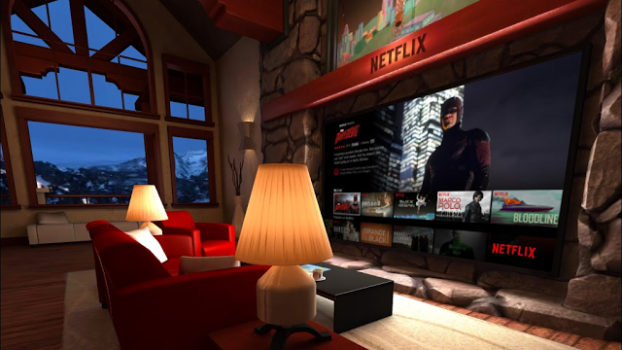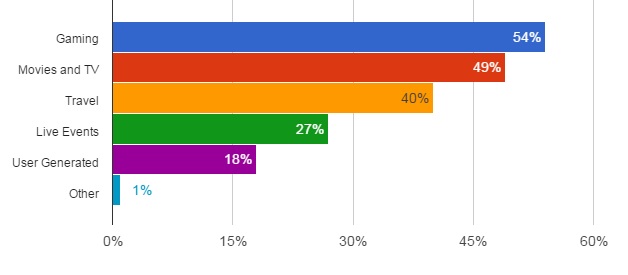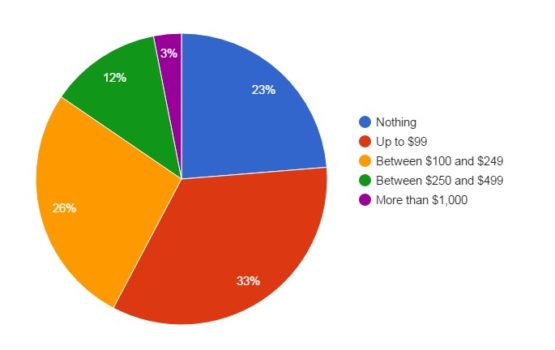
If there was any doubt, two new reports out this week confirm that we have the first killer app for virtual reality, and it’s watching videos.
That might come as a surprise to people who expected immersive, first-person games to be more attractive, or virtual meetings and socializing.
However, watching videos in a virtual reality headset offers a couple of advantages over watching them the normal way, and avoids many of the problems otherwise associated with virtual reality.
Last week, Oculus VR reported that 80 percent of Gear VR users spend their time watching videos, and seven of its top ten apps are video-related.
And yesterday, Interactive Broadband Consulting Group, LLC released the results of a survey showing that movies and TV had the highest appeal across demographic categories.
“Movies and TV had about 50 percent interest in almost all age groups,” the report said. “No other content category attracted this level of widespread appeal.”
According to the report, about 17 percent of 8,000 online consumers surveyed said they were interested in virtual reality, with men twice as interested as women.
According to the researchers, this indicates a healthy user base of potential early adopters for the technology.
Male respondents had more interest in gaming then women, while female respondents were 35 percent more interested in travel-related experiences.

And, earlier this year, Google reported that 350,000 hours of virtual reality videos have been watched on YouTube.
Why watch movies in VR?
You can watch both traditional, flat-screen, movies in virtual reality as well as 360-degree films. But why bother?
Even the 360-degree videos can be watched on a regular monitor or mobile device, using a mouse or touch to move the view around to different directions.
There are some benefits, however.
- Privacy: When you put on a headset and ear buds, you are in your own world. You can be in a house crowded with other people, or on a long plane trip, and you don’t have to worry about anyone looking over your shoulder.
- Presence: Virtual reality puts you right into the middle of the scene. With traditional videos, that just means that you’re sitting in a virtual theater looking at a large movie screen. With 360-degree and VR videos, however, you’re right in the middle of the action.
- Eye contact: In immersive videos, when actors talk directly to the camera, it feels as though they are talking directly to you, one-on-one. It makes for a more personal and powerful experience.
In addition, watching videos reduces some of the problems otherwise associated with virtual reality.
- Less lag, or no lag at all: Mobile devices are pretty good at playing videos. They can download them ahead of time, or buffer them, so that the viewing experience is seamless. Plus, playing back videos doesn’t require any heavy-duty graphics processing, which can slow down some games.
- Less motion sickness: Virtual reality viewers can get nauseous if it feels like they’re moving inside the virtual reality, but their physical bodies are actually staying still. When watching traditional videos, their virtual avatars are sitting still in a virtual theater sit, mirroring their physical bodies. With immersive videos, filmmakers can keep the camera steady and cut between locations instead of physically moving the camera. When camera movement is required, they can use framing — such as a cockpit window — to help anchor the viewer.
- No cables: Unlike high-end, tethered headsets such as the Oculus Rift and the HTC Vive, mobile-based headsets are completely self-contained and can be used anywhere.
- Instant gratification: Mobile devices turn on quickly and videos load fast, especially in areas with good connectivity. There’s no need to wait for a desktop to boot up. Plus, there’s no need to connect the headset — the phone drops right in and its ready to go.
The price difference
The Samsung Gear VR, currently the gold standard for mobile-based virtual reality headsets, is just $99. Cardboard-compatible headsets, all of which are also decent for video watching, can cost less — sometimes a lot less.
That means that users don’t have to make a big financial commitment to try out virtual reality.
In fact, according to the IBB survey, only 18 percent of people interested in virtual reality are willing to spend more than $250 for a headset. That’s still a lot of people, but it does offer a big market opportunity for lower-cost sets.

How about OpenSim and other social virtual platforms?
The low interest in social virtual reality and user-generated content may have implications for the early device market, said the IBB Consulting report.
Part of this could simply be the lack of available options.
AltspaceVR is one of the few platforms currently offering usable social virtual reality, with Second Life and OpenSim viewers suffering from significant lag and usability problems and no mobile support. This might change as big players like Facebook enter this space.
Plus, compared to watching online videos, social virtual worlds have always been a very niche market.
However, non-immersive socializing is extremely popular online, so as technology improves, the barriers to adoption may fall.
For example, translating physical gestures into virtual reality currently requires specialized equipment, and there are yet no standard tools — no virtual equivalent of the mouse. Similarly, social immersive applications are currently siloed, requiring separate downloads and learning curves for each one. A single ubiquitous browser, a virtual equivalent of Netscape, that makes it as simple to use social virtual reality as to watch a video, could solve this problem, as well.
- OSgrid back online after extended maintenance - April 16, 2025
- Analysts predict drop in headset sales this year - March 25, 2025
- OSgrid enters immediate long-term maintenance - March 5, 2025
